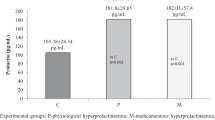Abstract
This paper analyzes possible dopamine (DA) mediated cadmium effects on plasma levels of prolactin, growing hormone (GH) and adrenocorticotropic hormone (ACTH), and if these changes are related to metal accumulation. For that purpose, adult male rats were treated with 50 mg/L of CdCl2 in the drinking water for one month. Plasma levels of prolactin, ACTH and GH were measured by specific double antibody radioimmunoassays. DA was measured by high performance liquid chromatography using electrochemical detection. Cadmium content in the tissues was measured by atomic absorption spectometry with graphite furnace. Analysis was performed by using a T-Student test. Metal exposure increased DA content (34.79±3.06vs. 18.2±2.88 pg/mg protein) and decreased its turnover (0.40±0.07vs. 0.75±0.06) in posterior hypothalamus. Cadmium also decreased DA turnover in median eminence (0.48±0.15vs. 1.50±0.63). Plasma levels of prolactin and GH decreased (2.4±0.11vs. 3.1±0.15 ng/mL and 5.37±0.05vs. 9.87±1.8 ng/mL respectively), while those of ACTH increased (2.73±0.14vs. 1.7±0.16 ng/mL). Cadmium concentration increased in both hypothalamus (4.88±0.34vs. 0.72±0.2 μg/g) and pituitary (22.82±4.57vs. 5.02±1.25 μg/g) after the metal exposure. These results suggest that cadmium effects on the secretion of these hormones are not mediated by dopamine and might be correlated to the metal accumulation at pituitary level.
Resumen
Se estudia el posible efecto del cadmio sobre los niveles plasmáticos de prolactina, hormona del crecimiento (GH) y adrenocorticotropina (ACTH) mediados por la dopamina (DA), y si los cambios están relacionados con la acumulación del metal. Para ello, se han tratado ratas macho adultas con 50 mg/L de CdCl2 en el agua de bebida durante un mes. Las hormonas se miden por radioinmunoanálisis específicos. La DA y su metabolito DOPAC se miden por cromatografia líquida de alta resolución. El contenido de cadmio en el hipotálamo y la hipófisis se mide mediante cromatografía de absorción atómica con cámara de grafito. La exposición al metal aumenta el contenido de DA (34,79±3,06vs. 18,2±2.88 pg/mg proteina) y disminuye su tasa de recambio (0,40±0,07vs. 0,75±0,06) en el hipotálamo posterior. También disminuye la tasa de recambio de DA en la eminencia media (0,48±0,15vs. 1,50±0,63). Los niveles plasmáticos de prolactina y GH disminuyen (2,4±0,11vs. 3,1±0,15 ng/mL y 5,37±0,05vs. 9,87±1,8 ng/mL, respectivamente), mientras que aumentan los de ACTH (2,73±0,14vs. 1,7±0,16 ng/mL). La concentración de cadmio aumenta en el hipotálamo (4,88±0,34vs. 0,72±0,2 μg/g) e hipófisis (22,82±4,57vs. 5,02±1,25 μg/g) tras la exposición al metal. Estos resultados sugieren que los efectos del cadmio sobre la secreción de estas hormonas no son a través de la dopamina, aunque se correlacionan con la acumulación del metal a nivel hipofisario.
Similar content being viewed by others
References
Andersson, H., Petersson-Grave, K., Lindqvist, E., Luthman, J., Oskarsson, A. and Olson, L. (1997):Neurotoxicol. Teratol.,19, 105–115.
Arito, H., Sudo, A. and Suzuki, Y. (1981):Toxicol. Lett.,7, 457–461.
Baranski B. (1986):Arch. Toxicol. 58, 255–260.
Bujis, R. M. and Van Eden, C. G. (2001):Prog. Brain. Res.,126, 117–132.
Casanueva, F. F., Villanueva, L., Dieguez,et al. (1986):J. Clin. Endocrin. Metab.,62, 186–191.
Chandra, S. V., Kalia, K. and Hussain, T. J. (1985):J. Appl. Toxicol.,5, 378–381.
Das, K. P., Das, P. C., Dasgupta, S. and Dey C. C. (1993):Biol. Trace Elem. Res.,36, 119–127.
Desole, M. S., Miele, M., Esposito, G., Fresu, L., Enrico, P., De Natale, G., Anania, V. and Miele E. (1991):Clin. Ther.,31, 229–234.
Esquifino, A. I., Arce, A., Villanua, M. A. and Cardinali D. P. (1997):J. Pineal Res. 22, 52–58.
Hagan, D. M. and Brooks A. N. (1996):J. Endocrinol.,151, 439–447.
Hrdina, P. D., Peters, D.A. and Singhal R. L. (1976):Res. Commun. Chem. Pathol. Pharmacol.,15, 483–493.
Lafuente, A. and Esquifino, A. I. (1998):Biometals,11, 183–188.
Lafuente, A. and Esquifino, A. I. (1998):Biometals,11, 235–241.
Lafuente, A., Blanco, A., Marquez, N., Alvarez-Demanuel, E. and Esquifino, A. I. (1997):J. Physiol. Biochem.,53, 265–270.
Lafuente, A., Álvarez-Demanuel, E., Márquez, N. and Esquifino A. I. (1999):Arch. Toxicol.,73, 60–63.
Lafuente, A., Márquez, N., Piquero, S. and Esquifino, A. I. (1999):Toxicol. Lett.,104, 27–33.
Lafuente, A., Márquez, N., Pazo, D. and Esquifino, A. I. (2000):Biometals,13, 47–55.
Lafuente, A., Márquez, N., Perez-Lorenzo, M., Pazo, D. and Esquifino, A. I. (2000):Food Chem. Toxicol.,38, 913–923.
Lafuente, A., Márquez, N., Perez-Lorenzo, M., Pazo, D. and Esquifino, A. I. (2001):Proc. Soc. Exper. Biol. Med. In Press.
Lopez, F. J., Dominguez, J. R., Sanchez-Franco, F. and Negro-Vilar A. (1989):Endocrinology,124, 527–535.
Lopez-Artiguez, M., Soria, M. L., Camean, A. and Repetto, M. (1993):Bull. Environ. Contam. Toxicol.,50, 417–424.
Lorenson, M. Y., Robson, D. L. and Jacobs L. S. (1983):J. Biol. Chem.,258, 8618–8622.
Nation, J. R., Frye, G.D., Von Stultz, J. and Bratton, G.R. (1989):Behav. Neuroendocr.,103, 1108–1114.
NRG: Guide for the Care and Use of laboratory Animals (1996). Institute of laboratory Animals Resources, Commission on Life Sciences, National Research Council, National Academy of Sciences (USA), National Institute of Health.
Zylber-Haran, E. A., Gershman, H., Rosenmann, E. and Spitz, I. M. (1982):J. Endocrinol.,92, 123–130.
Author information
Authors and Affiliations
Corresponding author
Rights and permissions
About this article
Cite this article
Lafuente, A., Márquez, N., Pazo, D. et al. Cadmium effects on dopamine turnover and plasma levels of prolactin, GH and ACTH. J. Physiol. Biochem. 57, 231–236 (2001). https://doi.org/10.1007/BF03179816
Received:
Issue Date:
DOI: https://doi.org/10.1007/BF03179816




